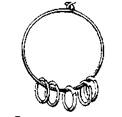home
 Economy Economy
 books books
 The history of the world economy - Polyak GB The history of the world economy - Polyak GB
|
The history of the world economy - Polyak GB
Building
The Egyptians were skilled builders. The magnitude of the compact built-up area and the massiveness of any one of the modern buildings are not surpassed the Egyptian pyramids. From the materials that were used for the construction of the highest Egyptian pyramid, you can build a dam along the Mediterranean coast of Egypt width of one and two meters in height. To bring so many materials on modern railways in Egypt, it would take four times more cars. The first pyramids were built as early as in the XXVII. BC. e. About knowledge in those days, astronomy and geometry indicated by the fact that all the pyramids have the same direction of the axes, and the sides of the pyramids are oriented to the cardinal points, and the deviation from the north do not exceed a tenth of a degree. Each year, the construction work was carried out about one hundred thousand people, are replaced every three months. For example, the Cheops pyramid was constructed 20 years. The length of the base of the pyramid 232.4 m, height of 146.7 m. The tomb is composed of about 2,500 stone slabs, each weighing 2.5 tons. According to the calculations of Herodotus, the construction of the pyramid there were 1,600 talents of silver (from 40300 to 60100 kg). In the time of Herodotus for the talent of silver you could buy 3,000 pigs.
Already in the period of the Old Kingdom Egyptians had good stone processing technology. For getting it used various metal tools: pick, drill, hammer. In the treatment of the stone used adzes, chisels. Stone polishing with quartz sand.
Besides the pyramids, temples and palaces were built in the country roads, and canals. Navigable channels were built to bypass the rapids of the Nile, for the passage of ships from the Nile to the Red Sea.
The Egyptians created the original architecture that differs monumentality, uniqueness of columns, pylons. An example is the temple of Amun in Thebes (Karnak), adorned with 134 columns arranged in 16 rows. Hall in the Temple had an area of 50 thousand. M2.
Constructed as administrative, craft and trade centers of the city were built not chaotic, and specially composed project. Straight streets crossed at right angles. Separate areas were created for the rich and poor residents. In the houses of the rich, there were up to 70 rooms. It is surrounded by brick walls.
Good fertile soil of Egypt and skills allow farmers not only to provide the rural population with food, but also create surplus product. Early separation from agriculture crafts became the basis of the exchange between rural and urban populations. An internal trade. At the same time, not enough metal in the country. They had to buy abroad or replenish resources from conquered countries. Copper was imported from the Arabian Desert and the Sinai Peninsula, and later in Cyprus. Gold imported from Nubia. Wood imported from Lebanon and Equatorial Africa. From Asia Minor brought iron from Mesopotamia - bronze, lapis lazuli, as well as horses.
Even during the Old Kingdom have developed trade routes from Egypt to Nubia, Sinai, Palestine and Syria. In the same period, there were weight metallic money in the form of ingots. During the period of the New Kingdom in Egypt it is already widely used monetary weight unit - deben equal to 91 g, which is divided into ten equal parts. Large trade transactions are documented in a special public places, in front of witnesses, whose names are recorded in the documents.

Egyptian money ring strung on a hoop
The science
The development of crafts, trade, navigation accompanied by the emergence of scientific knowledge. This knowledge is first transmitted orally. Then, for the development of schools were set up, where were taught not only to write, but also to give knowledge of mathematics, astronomy, medicine.
Knowledge of mathematics used in the determination of land areas and volumes of buildings. The Egyptians developed the decimal system. They were able to determine the area of a triangle, rectangle, trapezoid and a circle, calculate the volume of a truncated pyramid and the world, solve algebraic equations with one unknown.
In the field of astronomy, they were able not only to distinguish the planet, but also to make maps of the sky. Egyptian calendar year was divided into 12 months of 30 days each. By the end of the year added 5 days and it was equal to 365 days.
Quite been developed medical knowledge. Preparation of mummies has served as the basis for the accumulation of knowledge in anatomy, pharmacology. Egyptians passed in scientific treatises and textbooks knowledge of surgery, pharmacology, described the vessels circulation, symptoms and treatment of various diseases.
Egyptian science, art became a significant contribution to the world's treasury of knowledge, we had an enormous influence on the development of European civilization.
Review Questions
1. Describe the development of agriculture in ancient Egypt.
2. What are the most important types of crafts were developed in ancient Egypt?
3. Tell us about the construction in ancient Egypt.
4. How did the development of crafts and trade in ancient Egypt on the formation of scientific knowledge?


Comments
Commenting, keep in mind that the content and the tone of your messages can hurt the feelings of real people, show respect and tolerance to his interlocutors, even if you do not share their opinion, your behavior in terms of freedom of speech and anonymity offered by the Internet, is changing not only virtual, but real world. All comments are hidden from the index, spam control.